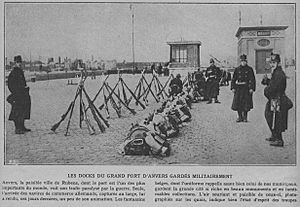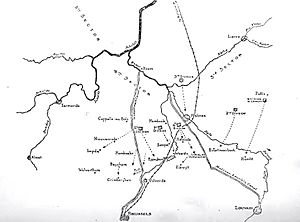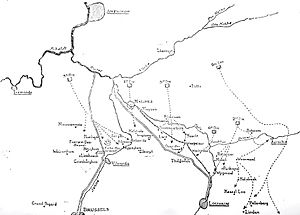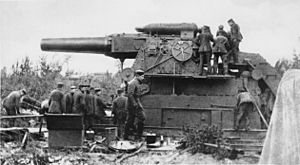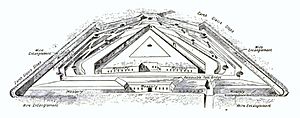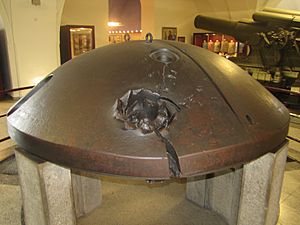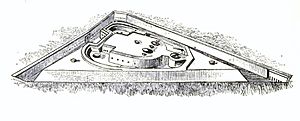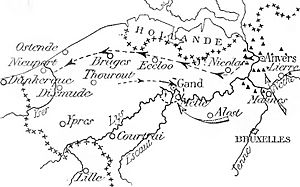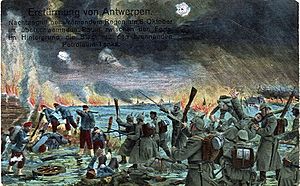Siege of Antwerp (1914) facts for kids
Quick facts for kids Siege of Antwerp |
|||||||||
|---|---|---|---|---|---|---|---|---|---|
| Part of the Western Front of the First World War | |||||||||
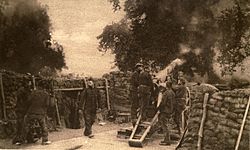 Belgian artillery positions around Antwerp |
|||||||||
|
|||||||||
| Belligerents | |||||||||
| Commanders and leaders | |||||||||
| Strength | |||||||||
| 66,000 (during main assault) | 87,300 field troops 63,000 garrison troops |
||||||||
| Casualties and losses | |||||||||
| Belgium: 33,000 interned in the Netherlands 30,000 captured Britain: 57 killed 1,480 interned 900 captured |
|||||||||
The Siege of Antwerp was a big battle during World War I. It happened in 1914 around the city of Antwerp in Belgium. German forces fought against Belgian and British armies.
Antwerp was a very important city. It had many forts around it, like a giant shield. These forts were called the National Redoubt. German troops surrounded the city after they invaded Belgium in August 1914.
The Belgian army in Antwerp tried to break out three times. These attacks, called "sorties," made the Germans change their plans. The Germans needed to send more troops to France. But the Belgian attacks kept some German soldiers busy in Belgium.
On September 28, the Germans started bombing the Belgian forts. They used very powerful cannons. The Belgian soldiers knew they could not win without help. Even when British troops arrived, the Germans broke through the outer forts.
The Germans then started to close off the escape route for the Belgians. This route went along the Dutch border to the coast. So, the Belgian army began to leave Antwerp and head west.
On October 9, the remaining Belgian soldiers in Antwerp gave up. The Germans took control of the city. Some British and Belgian troops escaped to the Netherlands. They stayed there for the rest of the war. The Belgian army that escaped went to the Yser river. They dug in there and fought the Battle of the Yser. This battle helped defend the last part of Belgium that was not taken by Germany.
Contents
Why Antwerp Was Important
Antwerp was a very strong city. It had many forts and defenses. People thought it could not be captured. For many years, Belgium planned to use Antwerp as a safe place. If other parts of Belgium were attacked, the army could retreat to Antwerp. They would wait there for other countries to help.
The city had old forts built in the 1860s. These were about 3 miles (5 km) from the city. It also had a newer ring of 21 forts. These were built after 1882, about 6 to 9 miles (10–15 km) from the city. There were also forts along the Scheldt river and areas that could be flooded to stop enemies.
German Invasion of Belgium
On August 2, 1914, Germany asked Belgium if its troops could march through Belgium to France. Belgium said no. On August 4, Germany invaded Belgium. The Belgian army tried to stop them.
The Germans first attacked Liège, another fortified city. The battle for Liège began on August 5. The Germans captured Liège by August 16. The Belgian army fought bravely but had to retreat.
By August 17, many German troops were in Belgium. The Belgian army realized they could not stop such a large force alone. On August 18, the Belgian army was ordered to retreat to Antwerp. They arrived on August 20.
On the same day, Brussels, the capital of Belgium, was captured by the Germans. The Belgian government moved to Antwerp to stay safe. The Germans then sent troops to surround Antwerp.
Planning the Attack
German Attack Plan
Before the war, Germany had a plan to attack Antwerp. This plan was to stop Belgian and British troops from threatening the German army in France. The plan involved many divisions attacking from the east.
In 1914, the German general, Hans von Beseler, changed the plan. He decided to attack Antwerp from the south. They would target specific forts like Walem and Sint-Katelijne-Waver. Then, they would move north. The Germans brought in very large cannons for this attack. These cannons could destroy forts from far away.
Belgian Defenses
Belgian engineers worked hard to build defenses around Antwerp. They dug trenches between the forts. They also created floods to slow down the enemy. However, the trenches were not very deep because of the water underground. Also, they cleared the land in front of the forts. This made the forts easier for the Germans to see.
The Siege Begins
First Belgian Attack (Sortie)
The Belgian army made its first attack from Antwerp on August 25. They wanted to help French and British troops fighting elsewhere. They hoped to distract the German forces around Antwerp.
Four Belgian divisions moved south from Mechelen. They aimed to cut German supply lines. However, the attack stopped on August 26. The Belgians learned that the French and British were retreating. So, the Belgian forces returned to Antwerp.
On the night of August 25, a German airship bombed Antwerp. Ten civilians died. But the bombing did not make the soldiers give up.
Second Belgian Attack
After the first attack, the Belgian army worked on improving the defenses. The Germans also made their positions stronger. The Belgians learned that the Germans were planning to attack their western side.
The Belgian army decided to try another attack. They wanted to make the Germans bring back troops from France. On September 10, Belgian cavalry reached the city of Leuven. The Germans had to send more troops to stop this attack. The Belgian advance was stopped, and the army returned to Antwerp by September 13.
Third Belgian Attack

The German army had left a gap in their lines north of Antwerp. This gap allowed Antwerp to stay in touch with the rest of Belgium. After another siege in France, Germany moved its super-heavy cannons towards Antwerp.
On September 25, the French asked Belgium for another attack from Antwerp. The Belgians planned one, but they saw signs that Germany was preparing a big attack on Antwerp. So, they reduced the number of troops for their attack. The Belgian attack made a small advance but was pushed back. On September 28, the German bombing of Antwerp's forts began.
The Main Battle
Heavy Bombardment
The German bombing started on September 28. German cannons, guided by observation balloons, hit the forts very accurately. By September 29, Fort Sint-Katelijne-Waver was destroyed. Fort Walem was also badly damaged.
The Belgian army headquarters began planning to leave Antwerp. They moved wounded soldiers, supplies, and equipment out of the city. The escape route crossed the Scheldt river on two narrow bridges. Trains moved out at night without lights.
On September 29, the Belgian Prime Minister told the British that if the outer forts were lost, the government and army would go to Ostend. They would leave the fortress troops to defend Antwerp as long as possible. The next day, Belgium officially asked Britain and France for help.
German Advance
On October 1, the German attack began on Forts Sint-Katelijne-Waver and Walem. By 11:00 a.m., Fort Walem was badly damaged. The Germans captured the land between the forts. The Belgian commanders ordered their army to pull back to a new defense line. This new line was north of the Nete river.
Fort Sint-Katelijne-Waver was taken on the night of October 1. Walem was captured on October 2. The Germans used all their cannons to bomb them. Forts Walem and Koningshooikt fell to the Germans. The Belgians had to leave or surrender other defenses.
On October 3, the Duffel redoubt was left by the Belgians because they ran out of ammunition. German cannons then focused on Fort Kessel. On October 4, German super-heavy guns bombed Fort Kessel, forcing its defenders to leave.
British Royal Marines arrived on October 4. They took positions around Lier. The Germans attacked and crossed the Nete river. They also tried to cross the Scheldt river.
On October 5, German soldiers crossed the Nete river near Lier. They used a small bridge. The Germans continued their attacks. On October 6, Fort Broechem was destroyed and left by the Belgians. The Belgian commanders decided to keep defending Antwerp. The Germans had not yet brought their heavy guns close enough to hit the inner forts.
On October 6, British naval brigades arrived to help. They took positions in the inner ring of forts. The trenches there were shallow and easy to see.
The German army was also moving west, threatening to cut off the Belgian army's escape route from Antwerp. On October 6, the British and Belgians decided to move the Belgian army to the west side of the Scheldt river. This would keep them in touch with any rescue forces. On the night of October 6, most of the Belgian army crossed the river. British forces were ordered to defend as long as possible.
On October 7, German soldiers crossed the Scheldt river at Schoonaarde. The Belgians tried to counter-attack but failed. The escape route from Antwerp became very narrow. The Belgian army was ordered to retreat further west, to the Terneuzen Canal.
By the night of October 7, the Belgian 2nd Division, British Royal Naval Division, and fortress troops held the inner forts. The rest of the Belgian army was moving west. German super-heavy cannons were moved across the Nete river. At 11:25 p.m. on October 7, German cannons began to bomb the city of Antwerp itself.
Belgian Retreat
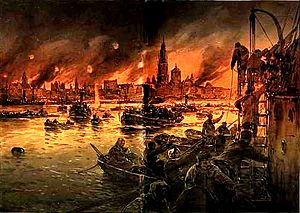
On October 8, the Belgian army continued its retreat. Most of the army moved west of the Ghent–Zelzate Canal. The Germans were closing in on the escape route at Lokeren. In Antwerp, German heavy cannons were bombing the inner forts and the city.
Fires started in the city because the waterworks were hit. The shelling of the forts caused little damage, but the Germans attacked other forts to cut off the garrisons. False reports reached the Belgian and British commanders that some inner forts had fallen. This led to a decision to abandon the inner line at dusk.
The Belgian and British commanders decided to continue defending Antwerp with the garrison troops. They would move the Belgian 2nd Division and British troops across the Scheldt. When the false report was corrected, they decided that if the forts were lost, the Royal Naval Division would withdraw at dusk. News arrived that the forts had fallen at 5:00 p.m. Orders were sent for the Belgian 2nd Division and the British to retreat.
The Belgian division withdrew and crossed the Scheldt by 11:30 p.m. The British began to retreat at 7:00 p.m. However, some British soldiers did not get the orders. They found the bridges being destroyed and under German fire. They used barges and boats to cross the river. About 1,500 British soldiers, half of the original group, were interned in the Netherlands.
By the night of October 8, the Belgian army had escaped from Antwerp. They gathered northwest of Ghent. The Germans did not realize the Belgians had left. They continued to advance towards the city. On October 11, German troops advanced on Ghent. By then, the Belgian fortress troops had joined the field army. The Belgians began a planned withdrawal from Ghent. German troops entered the city later that day.
Antwerp Surrenders
Early on October 9, German troops found some inner forts empty. General Beseler, the German commander, stopped the bombing. He asked the Belgian Military Governor, General Deguise, to surrender. Civilian leaders from Antwerp also met with Beseler. They asked him to stop bombing the city.
Under the threat of more bombing, the civilian leaders signed a surrender for the city. On the morning of October 10, the Military Governor's Chief of Staff arrived to discuss surrender. He found that the terms had already been accepted.
About 30,000 Belgian soldiers from the Antwerp garrison surrendered. The city was occupied by German troops until November 1918. About 33,000 Belgian soldiers fled to the Netherlands. They were kept there for the rest of the war. British troops were interned in Groningen, Netherlands. Many civilians also left Antwerp in 1914. Most returned after the siege.
What Happened Next
Later Operations
The Belgian forces that escaped from Antwerp had been fighting for two months. King Albert I wanted to rest the army. But he was convinced to keep fighting in Belgium. The Belgian army gathered along the Yser river. They wanted to hold on to the last part of Belgium that was not captured.
On October 14, the Belgian army began to dig in along the Yser. On October 18, German troops began attacking the Belgian positions. This started the Battle of the Yser. The Belgian army held this area until late 1918. Then, they helped free Belgium.
The Allied forces near Ghent withdrew on October 11. The British 7th Division moved to Ypres. The French marines went to Dixmude. By October 18, the Belgian, British, and French troops had formed a new line in northern France and Belgium. This line stretched from La Bassée Canal to Nieuport.
See also
- Constant Permeke – Belgian artist who served in the Belgian army and was wounded during the siege of Antwerp


